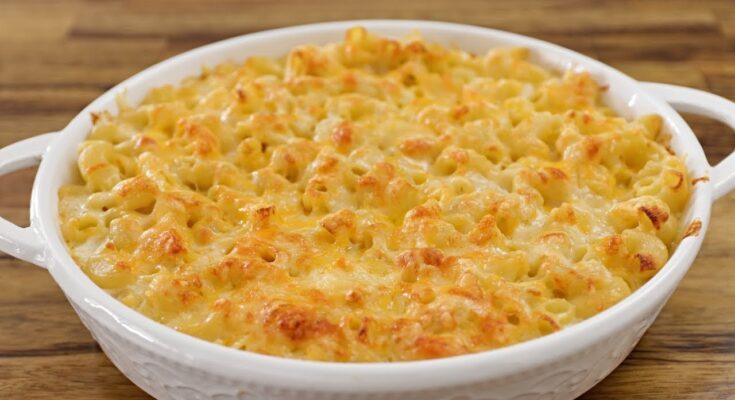Simple Mac and Cheese Recipe: Who doesn’t love a creamy, cheesy, and comforting bowl of mac and cheese? Whether you’re looking for a quick weekday dinner or a side dish for a gathering, mac and cheese is a go-to recipe loved by kids and adults alike. It’s simple, satisfying, and can be customized with endless variations.
In this guide, we’ll show you how to make mac and cheese from scratch with just a few pantry staples. No more relying on boxed versions—this homemade recipe is rich, creamy, and bursting with flavor.
Ready to dive into cheesy goodness? Let’s get started!
Ingredients Needed for Mac and Cheese
Basic Ingredients:
- 2 cups elbow macaroni (or any pasta of choice)
- 2 cups shredded cheddar cheese (sharp or mild based on preference)
- 2 tablespoons butter
- 2 tablespoons all-purpose flour
- 2 cups milk (whole milk or 2% for creaminess)
- 1/2 teaspoon salt
- 1/4 teaspoon black pepper
- 1/4 teaspoon garlic powder (optional)
Optional Add-ins for Extra Flavor:
- Breadcrumbs – For a crispy topping if baking.
- Parmesan Cheese – Adds depth and extra cheesiness.
- Paprika or Chili Flakes – For a hint of spice.
- Cooked Bacon Bits – To add a smoky flavor.
- Vegetables like Broccoli or Spinach – For a healthy twist.
These ingredients are simple, but they combine to create a dish that’s creamy, cheesy, and absolutely irresistible!
Kitchen Tools and Equipment Required
Essential Tools:
- Large Pot – To boil the pasta.
- Colander – For draining the pasta.
- Saucepan – For making the cheese sauce.
- Whisk – To stir the sauce smoothly.
- Mixing Spoon or Spatula – For stirring pasta and sauce together.
Optional Tools:
- Oven-Safe Dish – If you decide to bake your mac and cheese.
- Baking Sheet – To catch spills if baking.
- Grater – For freshly shredding cheese (recommended over pre-shredded).
Having these tools on hand ensures a smooth cooking process without any last-minute scrambling.
How to Make Mac and Cheese – Step by Step Guide
Step 1: Cooking the Pasta
The foundation of any great mac and cheese is perfectly cooked pasta. Follow these steps for the best results:
- Boil Water: Fill a large pot with water and bring it to a rolling boil. Add a pinch of salt for flavor.
- Add Pasta: Stir in 2 cups of elbow macaroni or your preferred pasta shape.
- Cook to Al Dente: Boil for 7–8 minutes or as per package instructions until pasta is al dente (firm to the bite). Avoid overcooking as the pasta will continue cooking when mixed with the sauce.
- Drain and Rinse: Drain the pasta using a colander. Rinse briefly with cold water to stop the cooking process and prevent sticking.
Tip: Save ½ cup of pasta water. It can be used to loosen the sauce later if it thickens too much.
Step 2: Preparing the Cheese Sauce
The cheese sauce is the heart of this recipe, and it’s surprisingly simple to make.
Making the Roux (Butter and Flour Base):
- Melt 2 tablespoons of butter in a medium saucepan over medium heat.
- Add 2 tablespoons of all-purpose flour and whisk continuously for 1–2 minutes until the mixture forms a smooth paste (roux).
Adding Milk and Cheese for Creaminess:
- Gradually pour in 2 cups of milk, whisking constantly to prevent lumps.
- Bring the mixture to a simmer and continue stirring until it thickens (about 3–4 minutes).
- Stir in salt, black pepper, and garlic powder for added flavor.
- Add 2 cups of shredded cheddar cheese, stirring until the cheese melts completely and the sauce is smooth and creamy.
Pro Tip: Use freshly grated cheese for the best meltability and flavor. Pre-shredded cheese often contains anti-caking agents that affect the texture.
Step 3: Mixing Pasta and Cheese Sauce
Now comes the fun part—combining the cooked pasta with the creamy cheese sauce:
- Add the drained pasta to the saucepan with the cheese sauce.
- Stir gently until all the pasta is well-coated and the sauce clings perfectly.
- Adjust consistency by adding a splash of milk or pasta water if needed.
Texture Tip: If you prefer a creamier consistency, don’t hesitate to add a little more milk or cheese while stirring.
Step 4: Baking (Optional Step)
Want to take your mac and cheese to the next level? Try baking it for a golden, crispy crust.
- Preheat the oven to 375°F (190°C).
- Transfer the mac and cheese mixture to a greased, oven-safe dish.
- Sprinkle a layer of breadcrumbs mixed with melted butter and a bit of Parmesan cheese on top.
- Bake uncovered for 15–20 minutes until the top is golden and crispy.
Why Bake It? Baking adds a crunchy texture to contrast the creamy filling, making the dish even more irresistible!
Serving Suggestions and Garnishing Ideas
Now that your mac and cheese is ready, it’s time to make it even more appealing with creative garnishes and side pairings.
Garnishing Ideas for Visual Appeal:
- Fresh Herbs: Sprinkle freshly chopped parsley, chives, or cilantro for a pop of color and a fresh aroma.
- Extra Cheese: Grate some Parmesan or sharp cheddar over the top just before serving.
- Paprika or Chili Flakes: Add a light dusting for a touch of heat and vibrant color.
- Bacon Crumbles: For a smoky, crunchy finish, sprinkle crispy bacon bits on top.
- Green Onions: Slice thinly and scatter over the dish to add a bit of crunch and flavor.
Pairing Ideas for a Complete Meal:
- Salad: Serve alongside a crisp garden salad with a tangy vinaigrette to balance the richness.
- Grilled Chicken or Fish: Add protein for a more filling meal.
- Garlic Bread: Perfect for scooping up the creamy sauce.
- Steamed Vegetables: Broccoli, carrots, or green beans make great side dishes to complement the flavors.
These suggestions add variety, making the meal feel complete and satisfying.
Common Variations of Mac and Cheese
Mac and cheese is versatile, allowing you to experiment with different ingredients to suit your taste.
1. Healthier Versions:
- Vegetable Add-ins: Add steamed broccoli, spinach, or peas for added nutrients.
- Whole Wheat Pasta: Replace regular pasta with whole wheat or gluten-free pasta.
- Low-Fat Dairy: Use low-fat milk and cheese for a lighter version without sacrificing flavor.
2. Spicy Mac and Cheese:
- Add diced jalapeños or a dash of hot sauce to the cheese sauce.
- Sprinkle cayenne pepper or smoked paprika for a mild kick.
3. Extra Cheesy Delight:
- Combine multiple cheeses like mozzarella, gouda, and Monterey Jack for deeper flavors.
- Top with more shredded cheese before baking for an oozy, cheesy crust.
4. Meat Lovers’ Mac and Cheese:
- Stir in cooked, crumbled bacon, sausage, or shredded chicken for a hearty meal.
- Add ground beef or pulled pork for a BBQ twist.
These variations can turn the classic mac and cheese into a gourmet masterpiece!
Tips for Storing and Reheating Leftovers
Mac and cheese tastes great fresh, but leftovers can be just as good if stored and reheated properly.
Storing Leftovers:
- Refrigerator: Store in an airtight container for up to 3–4 days.
- Freezer: Freeze portions in freezer-safe containers for up to 2 months. Make sure to cool completely before freezing.
Reheating Tips:
- Stovetop: Add a splash of milk and heat over medium-low, stirring frequently until warm and creamy.
- Microwave: Heat in short intervals (30 seconds) while stirring in between to prevent drying out.
- Oven: For baked versions, reheat at 350°F (175°C) covered with foil to retain moisture.
These methods will help maintain the creamy consistency and delicious flavor.
Nutritional Information
Here’s a quick look at the estimated nutritional value of a serving (1 cup) of homemade mac and cheese:
| Nutrient | Amount |
|---|---|
| Calories | 350–400 kcal |
| Protein | 15–18 g |
| Carbohydrates | 40–45 g |
| Fat | 15–18 g |
| Fiber | 2–3 g |
| Calcium | 200–250 mg |
Tips for a Healthier Version:
- Use low-fat milk and cheese to cut down on calories.
- Opt for whole grain pasta to boost fiber content.
- Add vegetables like spinach or kale for extra nutrients.
Common Mistakes to Avoid
Even simple recipes can go wrong without the right techniques. Here’s what to watch out for:
- Overcooking the Pasta:
- Boil until al dente, as overcooked pasta can become mushy when mixed with sauce.
- Grainy Cheese Sauce:
- Use freshly grated cheese and stir constantly to avoid lumps.
- Don’t overheat the cheese sauce—low and slow is the key.
- Too Thick or Thin Sauce:
- Adjust consistency by adding more milk if too thick or simmering longer if too thin.
- Skipping the Roux:
- A proper roux is essential to prevent the sauce from separating.
- Not Seasoning Properly:
- Taste the sauce before combining with pasta and adjust salt, pepper, or spices if needed.
By avoiding these common pitfalls, your mac and cheese will turn out perfect every time!
FAQs about Simple Mac and Cheese Recipe
1. What ingredients do I need for a simple mac and cheese recipe?
For a basic mac and cheese, you will need macaroni pasta, butter, all-purpose flour, milk, and a mix of cheeses like cheddar and mozzarella. Salt and pepper can be added for seasoning.
2. How long does it take to make homemade mac and cheese?
Typically, it takes about 20-30 minutes to prepare and cook a simple mac and cheese dish. This includes boiling the pasta and preparing the cheese sauce.
3. Can I use pre-shredded cheese for mac and cheese?
Yes, pre-shredded cheese can be used for convenience. However, for a creamier texture, it’s recommended to shred cheese off the block as pre-shredded cheese often contains anti-caking agents that can affect the sauce’s smoothness.
4. Is there a gluten-free option for mac and cheese?
Absolutely! Simply replace the regular pasta with your favorite gluten-free macaroni and use gluten-free flour for the sauce.
5. How can I add more flavor to my mac and cheese?
Enhance your mac and cheese by adding ingredients like garlic powder, mustard powder, smoked paprika, or even a pinch of cayenne pepper. For added texture and flavor, consider mixing in bacon bits, breadcrumbs, or fresh herbs like parsley.
6. Can mac and cheese be made ahead of time?
Yes, you can prepare mac and cheese in advance and refrigerate it. When ready to serve, reheat in the oven or on the stovetop, adding a splash of milk to loosen the sauce if necessary.
7. What’s the best way to reheat leftover mac and cheese?
Reheat leftovers in a microwave or on the stovetop over low heat. Add a little milk or cream to help the sauce regain its creamy texture.
8. Can mac and cheese be frozen?
Yes, mac and cheese freezes well. Store it in an airtight container and freeze for up to 2 months. Thaw overnight in the refrigerator before reheating.
Conclusion
Homemade mac and cheese is not only quick and easy but also endlessly customizable. Whether you like it creamy on the stovetop or baked with a crispy topping, this recipe is a guaranteed crowd-pleaser. With simple ingredients and step-by-step instructions, you can ditch the boxed version and enjoy rich, cheesy comfort food right at home.
So, next time you’re craving something warm and satisfying, whip up this delicious mac and cheese recipe and impress your family and friends.



